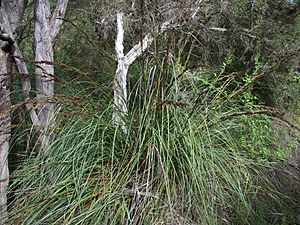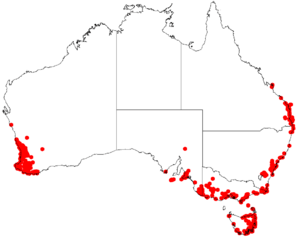Pithy sword-sedge facts for kids
Quick facts for kids Pithy sword-sedge |
|
|---|---|
 |
|
| Scientific classification | |
| Genus: |
Lepidosperma
|
| Species: |
longitudinale
|
 |
|
| Occurrence data from AVH | |
The Lepidosperma longitudinale is a type of plant called a sedge. It's also known as the pithy sword-sedge or pith saw-sedge. This plant stays green all year round. You can find it in wet, swampy areas across most parts of Australia. A French plant expert named Jacques Labillardière first described it in 1805.
Contents
What is the Pithy Sword-Sedge?
This plant grows in clumps. It's a perennial, meaning it lives for more than two years. It has a short, thick underground stem called a rhizome. The plant can grow from about 0.5 meters (1.6 feet) to 2 meters (6.6 feet) tall.
The main stems, called culms, stand up straight. They are smooth and have two curved sides. These stems are usually between 5 mm and 10 mm wide. They can also be quite sharp along their edges. The leaves of the pithy sword-sedge are yellow or red near the bottom. They have a dark, pointed tip.
Life Cycle: Flowers and Fruits
The pithy sword-sedge flowers between May and October. Its flowers grow in brown clusters called inflorescences. These clusters appear at the very top of the stems.
Each stem has small flower parts called spikelets. These spikelets are about 5 to 7 mm long. Each one holds 2 or 3 tiny flowers. After flowering, the plant forms fruits. These fruits are small, almost oval-shaped brown nuts. They are about 2 mm wide and 3 to 4 mm long.
Where Does it Live?
The pithy sword-sedge prefers to live in freshwater areas. You can often find it in swamps, along the edges of lakes, in floodways, and next to creeks. It also grows in places where water slowly seeps out of the ground.
This plant spreads by sending out its creeping rhizomes. These underground stems help new plants grow. This way, the pithy sword-sedge can form thick groups of plants, sometimes taking over an area.
The Role of Pithy Sword-Sedge in Nature
The pithy sword-sedge is an important part of its wet environment. It grows alongside other similar sedge species. These plants all like to live in damp, watery places.
Many animals use the pithy sword-sedge. For example, the Tasmanian bettong uses it as a safe place to hide. Birds like the Noisy scrub-bird, Southern emu-wren, and Red-winged fairy-wren use its leaves to build their nests.
This plant also helps tiny creatures. It acts as a host plant for certain moths. These include Elachista faberella, Elachista lachnella, and Elachista spathacea. The living plants and fallen leaves also help tiny microbes in the soil. These microbes can capture extra phosphorus from water runoff. This helps keep the wetlands healthy.

